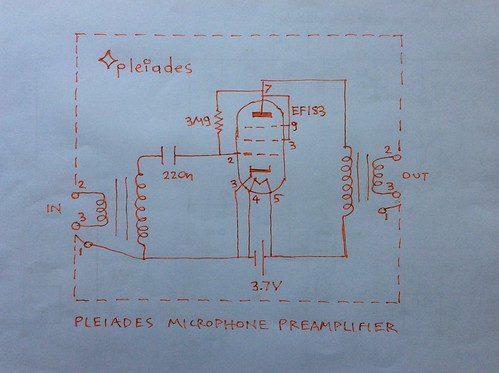The Pleiades V6 booster is open source as everything Pleiades.
A very important reference for Pleiades experiments is the recording of When I Fall in Love - Nat King Cole.
Below is the first signal path:
Sennheiser MD211 N - Sony TC-D5 Pro mic XLR input - Sennheiser HD580
All the above equipment are world class, on the league of the best mankind has made.
Yet the sound to listener's brain leaves so much to be desired. So if in a hurry one may by accident dismiss a singer, a world class mic, a world class analog preamp and recorder.
The sound as perceived by the listener's brain is bass heavy plus giving the impression of a tubby quality if the acoustics have low frequency reverberation. The direct and reverb bass heaviness masks the mid and high frequency detail. If the singer sings softly the gain on the TC-D5 has to be set near max so there is hiss too. This hiss is possibly not from the microphone thermal noise. If one sings very close to the mic the reverb almost disappears but still the sound is bass heavy even if MD211 is an omni mic and has no proximity effect. There is still hiss.
When the Pleiades V6 booster electron tube battery powered amplifier is inserted between the two equipment the sound immediately becomes big, clear, natural, with no hiss. Almost no hiss.
As if there is no electronics involved, just acoustic perception of the singing voice.
The difference is that by increasing the headphones volume control one can achieve a louder acoustic intensity for a given acoustic intensity voice than real life.
The world class MD211, TC-D5, HD580 headphones shine in their own right.
Signal path, setup:
(Test includes male voice singing When I Fall in Love - Young, Heyman)
Male singing voice - MD211 N - Pleiades V6 with Sowter 9126g 260mH input transformer - TC-D5 Pro mic XLR input - HD580 - listener
(The Sowter 9126g is a programable (user adjustable) inductance input transformer. See the euroelectron post with title Primary Transformer Inductance for the Sennheiser MD211).
Why such a difference?
One reason is that the inductance of the primary of the input transformer is 260mH which compensates for the bass heaviness and gives flat frequency response from singer's brain to listener's brain. [Lowe, Morgan]
260 millihenries is suited for this particular microphone at a given singing application. Another microphone would like to see another input transformer primary inductance, L, see nearby euroelectron posts. Inductance is not to be confused with impedance. Impedance of an inductor Z=ω times L, ω=2 times π times frequency, π is the ratio of circumference to diameter of any circle ie the Πυθαγόρας π or 3.14.....
(Note: Why does a shunt inductance reduce bass? Because the output impedance of the mic and L form a potential devider. At LF where the impedance of the inductor is decreasing it loads the mic and there is more voltage from across its impedance. Therefore the voltage output at the mic's terminals themselves drops).
A second reason is that the EF183 electron tube at such conditions is ultra low noise and the subtlest information that the mic gives passes through, is amplified. The gain on the excellent TC-D5 can be substantially decreased so it's thermal noise disappears. The recording level potentiometer can be set to 2-3 out of 10 instead of to 9-10 out of 10. The world class HD580 headphones are driven in a brilliant natural way.
Another reason may be the generous driving of the analog TC-D5 stages. At peaks there may be gradual peak limiting increasing average level and subjective level. [Hamm]. How much this effect takes place should be normally adjusted by the recording level knob.

Pleiades V6 schematic.
The coupling capacitor is 22nF and the anode to grid bias resistor is 6MΩ.
References:
Flat frequency response curve from brain to brain, Sound Picture Recording and Reproducing Characteristics - D. P. Loye and K.F. Morgan - J.S.M.P.E
Pleiades V6 Schematic
Tubes vs Transistors (vs operational amplifiers), is there an audible difference? - Russel O. Hamm - JAES
No comments:
Post a Comment